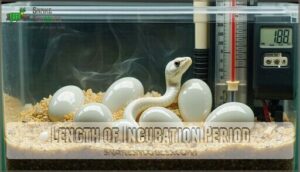This site is supported by our readers. We may earn a commission, at no cost to you, if you purchase through links.

You’ll find they’re seasonal breeders who time their reproduction carefully with warmer temperatures and longer daylight hours. Female milk snakes produce a single clutch annually, containing anywhere from 2 to 17 eggs depending on their size and health.
This once-yearly schedule allows them to conserve energy and guarantee favorable conditions for their offspring’s survival. The timing isn’t random – it’s nature’s way of giving baby snakes the best shot at thriving before winter arrives.
Understanding their breeding patterns reveals fascinating insights about survival strategies. The female milk snakes’ ability to time their reproduction with warmer temperatures and longer daylight hours is crucial for the snakes’ survival.
Table Of Contents
- Key Takeaways
- Milk Snake Reproductive Biology
- Reproductive Cycle of Milk Snakes
- Frequency of Egg Laying
- Egg Laying Season for Milk Snakes
- Number of Clutches and Eggs Per Clutch
- Incubation Period and Hatchling Development
- Maternal Care and Egg Incubation
- Factors Influencing Milk Snake Reproduction
- Frequently Asked Questions (FAQs)
- How often do milk snakes lay eggs?
- How long does it take for milk snakes to hatch?
- How long does it take a snake to lay eggs?
- Are all milk snake eggs fertile?
- How long do milk snakes incubate?
- How often do female snakes reproduce?
- What time of day are milk snakes most active?
- Where do milk snakes go in the winter?
- When do snakes lay eggs?
- How long are snake eggs?
- Conclusion
Key Takeaways
- You’ll find that milk snakes lay eggs just once per year, typically during late spring or early summer when temperatures warm and daylight hours increase.
- Each clutch contains 2-17 eggs on average, with larger, healthier females producing more eggs than smaller or younger snakes.
- Environmental factors, such as temperature, humidity, and photoperiod, trigger their breeding cycle, making proper conditions essential for successful reproduction.
- You’ll need to wait 50-70 days for incubation, during which maintaining a stable temperature (80-84°F) and high humidity (90%) ensures healthy hatchlings.
Milk Snake Reproductive Biology
If you’re curious about milk snake breeding, you’ll find these reptiles follow a predictable reproductive pattern that’s quite different from mammals.
Understanding their egg-laying behavior helps you provide proper care whether you’re observing wild snakes or keeping them as pets, which is crucial for their well-being and reproductive success.
Reproduction Method
You’ll find milk snakes use oviparity explained through their egg-laying reproduction method.
Milk snakes reveal nature’s egg-laying mastery through their perfectly timed reproductive strategy.
Internal fertilization occurs during spring mating, followed by minimal care once eggs are laid.
Their flexible strategy adapts to various environments, with temperature dependence essential for successful milk snake reproduction.
This snake egg laying approach represents the most common reproductive method among snake reproduction rates worldwide.
Egg-Laying Vs. Live Birth
Milk snakes choose oviparity over live birth, making them part of the 70% of snake species that lay eggs.
This evolutionary pressure favored eggshell composition that protects developing embryos while allowing gas exchange.
Unlike viviparity disadvantages such as energy-intensive pregnancy, milk snake reproduction through snake egg laying offers flexibility in timing and location.
- Freedom to choose: You’ll find females selecting perfect nesting spots without carrying developing young
- Energy efficiency: Mothers can focus resources on embryo nourishment within protective shells rather than internal development
- Survival advantage: Snake egg frequency allows females to reproduce even when food becomes scarce after laying
Frequency of Reproduction
Throughout their reproductive journey, milk snakes demonstrate remarkable breeding seasonality with annual cycles that sync perfectly with nature’s rhythm.
You’ll find these serpents typically reproduce once yearly, though clutch interval timing varies based on environmental influence.
Milk snake breeding occurs primarily in spring through early summer, when ideal conditions trigger their reproductive systems.
Snake egg frequency depends heavily on the female’s age and health status.
Young snakes reaching reproductive maturity around two years old may produce smaller clutches initially.
Egglaying frequency increases as females mature, with peak reproduction occurring in their prime years.
Clutch frequency ranges from one to three times annually under favorable conditions, though most wild populations stick to single yearly cycles.
Snake mating frequency correlates directly with environmental factors like temperature stability and prey availability, making understanding these patterns vital for successful captive breeding programs.
Reproductive Cycle of Milk Snakes
Your snake’s reproductive cycle follows nature’s clockwork precision.
After mating rituals in spring, females enter a vital gestation period where egg development occurs internally.
She’ll carefully select nesting sites like rotting logs or burrows, preparing the perfect environment.
The reproductive cycle demands significant energy as her body creates each egg’s protective shell and yolk.
Understanding milk snake breeding timing helps you recognize when she’s preparing to lay.
This egglaying frequency pattern directly impacts hatchling success rates in your breeding program.
They’re often mistaken due to mimicry of coral snakes.
Frequency of Egg Laying
Understanding how often your milk snake will lay eggs helps you provide proper care during breeding season.
Most milk snakes lay eggs just once per year, though several factors can influence this timing and frequency.
Most milk snakes reproduce once yearly due to nature’s careful timing and energy demands.
Number of Clutches Per Year
Most milk snakes lay one clutch per year during their breeding season.
Wild populations rarely exceed this frequency due to energy demands and environmental influence on reproduction. However, captive breeding programs occasionally achieve two clutches annually through controlled conditions and ideal nutrition.
Clutch frequency factors include the female’s age, health, and available resources. Wild variation exists across subspecies and geographic regions.
Snake egglaying timing depends on post-brumation recovery and environmental cues that trigger reproductive readiness.
Time Between Clutches
Understanding the timing between clutches helps you plan better if you’re breeding milk snakes.
After laying their first clutch, females typically wait 30 to 45 days before producing another.
This Recovery Period allows them to rebuild energy reserves and prepare internally for the next round.
Several factors influence this timing:
- Nutrient Accumulation: Well-fed females recover faster between clutches
- Environmental Adjustments: Temperature and humidity changes affect timing
- Climatic Influence: Warmer conditions can shorten intervals slightly
- Dietary Impact: Rich diets support quicker recovery
- Individual Health: Stronger snakes bounce back sooner
This natural spacing guarantees each clutch receives proper attention while maintaining the female’s health throughout breeding frequency cycles; Honduran Milk Snakes, for example, reach sexual maturity at 3 years old.
Factors Affecting Egg Laying Frequency
Several factors influence how often your milk snake lays eggs each year.
Age Influence plays a key role – younger females typically produce more clutches than older ones.
Climate Impact can’t be ignored either, as warmer temperatures encourage more frequent laying cycles.
Diet Quality directly affects clutch size variation and reproductive timing.
Well-fed snakes with adequate nutrition lay eggs more consistently than those with poor diets.
| Factor | Impact | Details |
|---|---|---|
| Age Influence | Decreases with age | Young females lay more frequently |
| Climate Impact | Warmer increases | Cold suppresses reproduction |
| Diet Quality | Rich diet boosts | Poor nutrition reduces frequency |
| Stress Levels | High stress reduces | Calm environments promote laying |
| Population Density | Crowding decreases | Space improves reproduction |
Environmental factors and snake reproductive biology work together, creating the perfect storm for successful milk snake eggs production.
Egg Laying Season for Milk Snakes
Understanding when milk snakes lay their eggs helps you provide proper care if you’re keeping these beautiful reptiles.
The timing of egg laying depends on specific environmental cues that trigger their natural reproductive cycle.
Environmental Triggers
Environmental changes act like nature’s alarm clock for milk snake reproductive habits.
When daylight length increases and temperature shifts occur in spring, females receive biological signals to begin their egg-laying cycle.
Key environmental triggers include:
- Photoperiod changes – longer days signal breeding season
- Temperature shifts – warming temperatures activate reproductive hormones
- Humidity levels – increased moisture supports egg development
- Seasonal shifts – spring conditions trigger mating behaviors
- Habitat conditions – suitable nesting sites become available
These environmental triggers work together to guarantee clutch timing aligns perfectly with favorable survival conditions for developing eggs.
Temperature and Humidity
Once rainfall signals breeding season, you’ll need to focus on incubation temperature and humidity levels for successful egg development.
Keep your nesting substrate between 80-84°F with 90% reptile egg humidity to prevent drying out.
Proper temperature and humidity control directly impacts hatchling success rates in your breeding setup.
| Temperature (°F) | Humidity (%) | Impact on Egg Development |
|---|---|---|
| 75-85 | 60-70 | Ideal for incubation |
| >85 |
Photoperiod and Egg Laying
As milk snakes sense springtime’s arrival, daylight influence becomes a powerful trigger for their reproductive cycle.
Extended light duration signals their bodies to begin seasonal breeding preparations.
Key photoperiod effects include:
- Breeding Season Onset: Longer daylight hours activate hormonal changes that initiate mating behaviors
- Egg Production Timing: Light duration helps synchronize snake egg production with favorable environmental conditions
- Latitude Effects: Northern populations respond to different photoperiod thresholds than southern milk snakes, affecting snake egglaying season timing
To further stimulate breeding, consider simulating a cooling period before introducing the snakes.
Number of Clutches and Eggs Per Clutch
When you’re caring for milk snakes, you’ll want to know exactly how many eggs they produce and how often.
Understanding clutch sizes helps you prepare proper nesting areas and plan for the care these future hatchlings will need.
Average Clutch Size
Most milk snakes produce clutches containing 8 to 12 eggs on average, though this varies substantially.
Female size directly impacts average clutch size – larger females typically lay more eggs.
Genetic influence and habitat conditions also affect egg composition and quantity.
Fertility rates in healthy populations exceed 80%, making milk snakes reliable reproducers when conditions align perfectly.
Range of Clutch Sizes
Looking at milk snake clutch sizes reveals nature’s remarkable adaptability. These serpents typically produce 2-17 eggs per clutch, though most average 6-15 eggs. Female size plays a vital role in determining output. Well-fed snakes produce larger clutches.
- Genetic variation: Different subspecies show distinct clutch size ranges
- Habitat influence: Environmental conditions directly impact egg production capacity
- Female size correlation: Larger mothers consistently produce more eggs per clutch
Snake clutch sizes demonstrate how evolution fine-tunes reproductive success across diverse habitats.
Factors Affecting Clutch Size
How do various factors shape milk snake clutch sizes? Multiple elements work together to determine how many eggs your snake will produce.
Female Size substantially impacts reproduction – larger females consistently lay more eggs than smaller ones. Snake Age matters too, as older snakes often produce fewer eggs.
Diet Quality proves vital since well-fed females invest more energy into larger clutches. Milk snakes thrive when provided proper habitat requirements, influencing their reproductive success.
| Factor | Low Impact | High Impact |
|---|---|---|
| Female Size | 6-10 eggs | 15-24 eggs |
| Nutrition | Poor diet = smaller clutch | Rich diet = larger clutch |
| Habitat Quality | Disturbed areas reduce size | Stable environments increase size |
Habitat Quality affects snake reproduction through nesting site availability and environmental stability.
Genetic Influence determines each snake’s reproductive potential, while stress reduces snake clutch size variation.
Understanding these factors affecting reproduction helps predict snake clutch frequency and snake clutch size factors in your breeding program.
Incubation Period and Hatchling Development
Once you’ve prepared the perfect nesting environment, your milk snake eggs will need about 50-70 days to develop before hatching into miniature versions of their parents.
The tiny hatchlings emerge completely independent and ready to hunt, measuring just 6-10 inches long with the same striking banded patterns that’ll help them survive in the wild, and they have the same characteristics as their parents.
Length of Incubation Period
You’ll wait roughly 50-70 days for your milk snake eggs to hatch. Temperature Effects drive this timeline – warmer conditions speed development while cooler temps slow it down.
Humidity Control and proper Incubation Substrates create the foundation for healthy Embryo Development. Many breeders source vermiculite incubation supplies to guarantee proper conditions.
- Optimal temperature range: Keep eggs between 80-84°F for consistent development
- Humidity requirements: Maintain 90% humidity using vermiculite or perlite substrates
- Monitoring progress: Use candling techniques to track embryo growth and guarantee Hatchling Success
Hatchling Characteristics
When you discover those tiny hatchlings, you’ll notice they’re remarkably independent from day one.
Size at birth ranges from 4-8 inches, sporting vibrant banding patterns that mimic coral snakes for protection.
Their initial shedding occurs within days of hatching, revealing brighter colors underneath.
These snake hatchlings possess sharp hunting instincts immediately, requiring no parental guidance for independent survival.
Their juvenile diet consists of small rodents, lizards, and insects.
Growth rate accelerates quickly with proper nutrition, doubling their length within months through efficient metabolism.
Post-Hatching Development
Your newly hatched milk snakes begin life as independent survival experts, requiring no parental guidance.
These miniature predators immediately start hunting small prey like insects and tiny rodents.
Juvenile growth happens rapidly during their first year, with proper hatchling diet being essential.
Reaching maturity takes 2-3 years, though predation risks remain high throughout this vulnerable period.
Maternal Care and Egg Incubation
Unlike many snake species that abandon their eggs after laying, you’ll find female milk snakes exhibit some protective behaviors during their reproductive period.
They don’t provide traditional parental care, but their energy investment in egg production and site selection represents a significant biological commitment that affects their annual reproductive capacity.
Female Snake Behavior
Female milk snakes demonstrate fascinating reproductive behaviors that maximize their breeding success. During the snake breeding season, females become highly selective about their environment and partners. You’ll notice these behaviors are perfectly adapted to their snake reproduction cycle.
Courtship Rituals begin when males detect pheromone signals from receptive females. The female’s role isn’t passive—she actively evaluates potential mates through complex interactions. Once mating occurs, her behavior shifts dramatically toward preparing for egg-laying.
Maternal Investment becomes evident as females carefully assess potential nesting sites. They’ll spend considerable time exploring locations before committing to one spot for their snake egg clutch. This behavior reflects the substantial energy costs of reproduction in their snake reproductive behavior patterns.
Here’s what drives female behavior during this critical period:
- Territory selection involves testing multiple locations for ideal temperature and moisture levels
- Energy conservation becomes paramount as females reduce activity to preserve resources for egg development
- Stress avoidance leads to increased wariness and defensive responses during the snake breeding cycle
These behaviors guarantee successful reproduction while minimizing risks to both mother and developing offspring.
Nesting and Egg Protection
When selecting nest sites, milk snakes pick spots that offer maximum protection from predators and environmental threats. You’ll find their eggs tucked away in rotting logs, abandoned burrows, and compost piles where temperatures stay consistent.
| Nesting Factor | Preferred Conditions | Protection Benefits |
|---|---|---|
| Location | Hidden underground spots | Shields from predators |
| Moisture | Humid microenvironments | Prevents egg desiccation |
| Temperature | Stable 75-85°F range | Guarantees proper development |
Clutch defense strategies involve careful site preparation rather than active guarding. Female snake nesting site selection focuses on nest microclimate control through substrate choice.
You can buy a snake egg incubator to help maintain proper conditions. While parental presence effects are minimal post-laying, the initial snake nesting and egg protection investment determines hatchling success rates for their snake clutch of eggs.
Energy Costs of Reproduction
You’re witnessing one of nature’s most demanding biological processes when milk snakes reproduce.
The metabolic demand skyrockets during egg development, requiring massive resource allocation from the female’s body reserves.
- Energy costs drain fat stores and muscle tissue during gestation
- Parental investment reduces future survival chances for mothers
- Clutch size tradeoffs balance offspring quantity versus quality
- Post-reproduction recovery takes months to restore body condition
This reproduction efficiency directly impacts reproductive success in future seasons.
Maintaining proper incubation temperature matters for successful hatching.
Factors Influencing Milk Snake Reproduction
While your milk snake’s reproductive success depends on several key factors, understanding what influences their egg-laying patterns will help you provide ideal care.
Environmental conditions, proper nutrition, and overall health status work together to determine how often and successfully your snake will reproduce each year, and these factors are crucial for reproductive success and ideal care.
Habitat and Environmental Factors
Your milk snake’s reproductive success depends heavily on where it calls home.
Temperature Influence drives egg-laying timing, with ideal ranges of 75-85°F triggering breeding behavior.
Humidity Levels around 60-70% create perfect Nesting Site Selection conditions.
Habitat Quality affects clutch frequency – fragmented environments reduce reproductive success, while stable milk snake habitat with proper shelter supports healthy snake breeding environment cycles.
Diet and Nutrition
Beyond environmental conditions, your milk snake’s nutritional intake directly impacts reproductive success. Well-fed females produce larger clutches with healthier eggs, while poor nutrition can cause skipped breeding cycles.
Your snake diet should prioritize variety and proper Nutritional Needs. Consistent access impacts overall snake health. Adequate pre-breeding nutrition guarantees females have sufficient energy reserves for egg development and laying.
Prey Availability varies between Wild Diet and Captive Diet scenarios:
- Wild snakes hunt rodents, birds, and lizards based on seasonal abundance
- Feeding Frequency increases before breeding season to build fat reserves
- Captive snakes need consistent feeding schedule with appropriately-sized prey
- Protein-rich diets correlate with higher fertility rates and clutch sizes
Health and Disease
A sick milk snake won’t invest energy in egg health or hatchling development.
Diseases and parasites create reproductive stress that reduces clutch quality and frequency. Watch for lethargy, breathing issues, or poor appetite—these signal problems affecting snake reproductive health and genetic defects in offspring.
| Health Issue | Impact on Reproduction |
|---|---|
| Respiratory infections | Reduced breeding frequency |
| Internal parasites | Poor egg development |
| Nutritional deficiencies | Smaller clutch sizes |
| Bacterial infections | Increased embryo mortality |
| Stress-related illness | Failed breeding attempts |
Healthy snakes produce better reptile egg clutch outcomes with stronger snake egg development patterns.
Frequently Asked Questions (FAQs)
How often do milk snakes lay eggs?
You’ll find that milk snakes typically lay eggs once yearly during spring or early summer.
Each clutch contains six to twenty-four eggs, with larger females producing more.
Environmental factors like temperature and food availability can influence their reproductive timing.
How long does it take for milk snakes to hatch?
About 70% of eggs successfully hatch after you’ve waited 50-70 days of incubation.
You’ll see your milk snake hatchlings emerge in late summer when temperature and humidity conditions remain stable throughout the development period.
How long does it take a snake to lay eggs?
Snake egg-laying duration varies by species, but it’s typically a quick process.
You’ll find most snakes lay their entire clutch within several hours to a day, depending on clutch size and individual snake health conditions.
Are all milk snake eggs fertile?
Not all your milk snake eggs will be fertile – you’ll find that fertility rates typically hover around 80% in wild populations.
You can’t predict which eggs are fertile just by looking at them initially, so you’ll need to incubate all eggs and monitor their development carefully.
How long do milk snakes incubate?
You’ll need patience during the 50-70 day incubation period. Temperature and humidity control are critical for successful hatching, so maintain consistent conditions throughout this extended development phase.
How often do female snakes reproduce?
Time flies when you’re caring for reptiles.
Female milk snakes typically reproduce once annually, laying their single clutch of eggs during late spring or early summer before taking time to recover and prepare for next year’s cycle, which can be a complete and caring process.
What time of day are milk snakes most active?
You’ll find milk snakes are most active during twilight hours—dawn and dusk—when they hunt for prey. They’re crepuscular creatures, preferring cooler temperatures over the heat of midday sun.
Where do milk snakes go in the winter?
Like winter’s blanket covering the earth, you’ll find your milk snake seeking underground refuges during cold months.
They brumate in burrows, rock crevices, or rotting logs below the frost line, entering a sleep-like state until spring’s warmth returns.
When do snakes lay eggs?
Snakes typically lay eggs during spring and early summer when temperatures warm up.
You’ll find most species, including milk snakes, laying their clutches between May and July for ideal incubation conditions.
How long are snake eggs?
Snake eggs typically measure between 1-2 inches long, though you’ll find size varies by species.
Milk snake eggs specifically reach about 30mm in length with elongated, leathery shells that feel flexible to touch.
Conclusion
Understanding how many times a year do milk snakes lay eggs reveals nature’s efficient design – these reptiles produce just one clutch annually, containing 2-17 eggs.
You’ve learned that timing matters more than frequency in their reproductive strategy.
Environmental factors like temperature and daylight trigger this once-yearly breeding cycle.
This singular focus allows females to invest maximum energy into successful reproduction rather than multiple attempts.
When you’re caring for milk snakes or studying their behavior, remember that patience aligns with their natural rhythm for ideal breeding success, and consider the importance of natural rhythm.
- https://mdc.mo.gov/discover-nature/field-guide/eastern-milksnake
- https://reptilesmagazine.com/honduran-milk-snake-breeding-tips/
- https://pmc.ncbi.nlm.nih.gov/articles/PMC2666681/
- https://www.chesapeakebay.net/discover/field-guide/entry/eastern-milksnake
- https://www.fs.usda.gov/sites/nfs/files/legacy-media/blackhills/pale_milk_snake.pdf

















